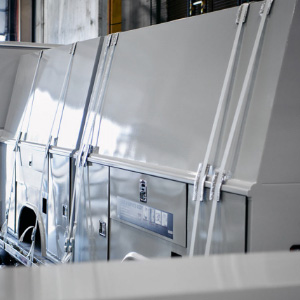Winter weather conditions can change within seconds, so you have to be ready for any situation. Taking the right steps to prepare for winter will help keep you safe and help your truck stay well-maintained. It also decreases maintenance costs while making for a more comfortable ride over the next few months.
Preparing a truck fleet for winter involves several preparation tips along with a complete emergency kit guide. We know your operations depend on efficient deliveries and transportations, so Reading Body is here to help you battle the cold weather and harsh road conditions.
Work Truck Winter Maintenance Tips
Driving in a winter wonderland is not the same when you’re hauling a massive load. Ice and snow can decrease tire traction, inhibit visibility and affect various components of your vehicle. Salt can cause engine corrosion and eat away at exterior parts. Winter conditions also cause the engine to work harder than usual.
The best way to combat the colder months is to prep your truck with the proper maintenance.
1. Inspect Battery
If your truck’s battery is close to the end of its lifecycle, replace it before winter begins. If it’s still in excellent condition, inspect it for corrosion. Ensure the connections are tight and clean, and that the battery is securely mounted.
You can perform a load test while also checking the starter and alternator. Examine all the electrical wiring for damage and frays, making sure there are no exposed or loose wires.
2. Examine Wiper Blades and Windshield
Replace your vehicle’s wipers if they are cracked and split, or swap your old ones out for winterized versions. Proper winter wiper blades prevent snow and ice buildup while also getting rid of salt contamination. Never buy cheap blades that can’t resist the elements. It’s an impractical investment that can affect your driving ability.
You should also top up the windshield wiper fluid or opt for a cold-temperature blend. Check that your defroster is working well so you can ensure complete visibility when snow and ice accumulate.
3. Install Engine Heater
Diesel engines need a higher cylinder temperature compared to gasoline vehicles, which makes them harder to start in cold weather. By installing an electric block heater, you can keep your engine warm while it’s off. It will help with smoother startups and keep your engine in better condition when freezing temperatures arrive.
4. Check Water Separator and Fuel Filter
Make sure your utility truck’s fuel filter is in excellent condition and make replacements as necessary. You should also monitor the water separator system. If water reaches your diesel fuel, it can contaminate the fluid and affect your engine.
Because most separators are not self-cleaning, drain the water by turning on the drain valve. It’s essential to perform this phase during winter because condensation can increase inside the fuel tank when the outside temperature is cold.
5. Inspect Air Dryer
An air dyer accumulates and gets rid of any contaminants from the air before they reach the brakes. It also prevents water from freezing in your brake lines. Drain the reservoir regularly and make sure it’s functioning. Replace it as needed. If you don’t tend to the dryer component, it can cause the truck’s brakes to malfunction.
6. Prepare With Fuel Additives
Diesel contains paraffin, which is a wax that can crystallize in the winter, making the fuel sluggish. The fluid won’t be able to transfer through the fuel filters and can affect the operation of your truck.
To avoid a sluggish engine, invest in high-cetane diesel fuel. You can also apply a fuel additive to enhance the vehicle’s performance. Refer to your owner’s manual for the exact specifications of your make and model to prevent ice buildups in the fuel filters.
7. Investigate Cooling System
Complete a comprehensive inspection of the cooling system for worn, cracked or damaged components. Look at the radiator, hose clamps and hoses for bulges or slits as well. Conduct a coolant test to make sure it’s at the right freezing temperature and use the proper winterized coolant fluid for your particular truck. Top-up and change the antifreeze as necessary.
8. Consider Winter Tires
Inflate your tires to the proper PSI before setting off on long routes. Without the right tire pressure, it can increase the risk of blowouts and cause less traction during slippery conditions. Each tire needs the correct amount of contact between its rubber and the road. Check for the proper inflation more often during the winter because cold temperatures can cause the pressure to drop faster.
You may also want to consider tire chains or winter tires for your truck. Chains can boost your braking, handling and acceleration control on slick roads. Without them, you run the risk of skidding and sliding.
If you live in a state or travel to one that requires tire chains, make sure you have the right number and correct size. Check them for rust, twists or damaged links before driving.
9. Review Four-Wheel and All-Wheel Drive Systems
If your truck has one or both options, make sure you know when and how to operate them. Both give your rig better traction in certain situations. You often have to set your vehicle to four-wheel drive while all-wheel drive usually automatically engages when you lose traction. Check your owner’s manual to learn the various settings of your truck.
10. Use Enhanced Oil
Engines can be harder to start in the winter because a vehicle’s oil can thicken, making it more difficult to circulate through the system. Check with your manufacturer to see if you can implement a thinner oil into your system to help with better startups.
11. Look at Belts and Hoses
Cold weather can do a lot of damage when and where you least expect it. Investigate under your hood for cracked, split or broken hoses and belts, replacing them immediately if damaged.
12. Wash Your Truck
Driving through salt, sand, ice, snow and other harmful contaminants can damage your truck’s paint job as well as its undercarriage components. Wash your vehicle regularly to prevent a buildup of chemicals and salt that can lead to rust and corrosion.
In Pennsylvania alone for the 2018-2019 season, the state used 11.6 million gallons of salt brine on the roads. Although some states don’t receive as much winter force, many still lay salt and other treatments on the streets.
On top of the major maintenance tips, it’s also smart to look at the weather forecast before your next journey. Know the conditions of the road before and during your trip, as well as the predicted patterns of what’s to come. You can stay up-to-date using apps, websites and the radio.
When you prepare your engine, tires, fluids and other vital components, you can ensure your truck is ready for any short or long-term trips, even when the weather isn’t in your favor.
What Should You Have in Your Truck’s Winter Emergency Kit?
The worst thing to happen when an unexpected hazard strikes it to be stranded with no supplies. It’s better to prepare now than needing to rely on emergency help. Several supplies to keep in your truck include:
- Blanket, gloves, scarf, hat and snow boots: Instead of keeping your truck in idle to stay warm, and to avoid the fumes, bundle up with the right clothing. The right apparel also provides protection if you’re outside working on the truck.
- Extra fluids: Have coolant, washer, oil, transmission and brake fluids on hand and check all the levels before driving. Because your engine will be working harder, you may need to top up different liquids more often.
- First-aid kit: Prepare with a first-aid kit in case of major and minor injuries.
- Flares and radio: When you need immediate help, radio for support and set up flares to warn other drivers.
- Flashlight and batteries: Use a flashlight to inspect various parts of your truck or during emergencies.
- Food, water and medicine: Stock up on canned food, bottled water and any medications you require. You can also carry snacks to ensure you remain energized on the road.
- Fuel filter: Replace the fuel filter when ice buildup is present.
- Jumper cables: Carry jumper cables if you find yourself with a dead battery.
- Lithium grease: Apply lithium grease to the truck’s fifth wheel for lubrication when traditional solutions are too cold.
- Old rags: Working with different fluids can get messy, so keep rags in the truck to handle spills.
- Phone charger and battery bank: Always make sure your phone is accessible, whether you need to check the weather or call for help.
- Salt, sand or cat litter: Any of these supplies can increase tire traction when you’re stuck in the snow or on ice.
- Snow shovel and ice scraper: Clear off your windows and dig yourself out of tricky situations.
- Spare tire and air pump: In the case of a blowout or other emergency, a spare tire will keep you on the road.
- WD-40: WD-40 helps lubricate various truck components like frozen locks.
- Zip ties and duct tape: Duct tape and zip ties can come in handy when you least expect, whether you need a quick fix or to tie a loose end.
The final piece of advice is to know your limits on the road. Never feel pressured to continue when conditions are unsafe. When in doubt, pull over and find a safe parking spot until the weather clears. Instead of surpassing your truck’s abilities, you can protect yourself, your vehicle and your fellow drivers. If you need additional support preparing your truck, refer to the professionals to keep everything aligned.
Rely on Reading Body
Learning how to prepare your truck for winter takes dedication and the right maintenance. At Reading Body, we offer service bodies for trucks that work for a range of industries. Our truck upfits give you a competitive advantage by helping you gain an extra level of efficiency and productivity. Since 1955, we have been one of the largest and leading truck equipment manufacturers in the USA, making us a superior choice for custom work and excellent warranties.
Contact us online to learn about our precision manufacturing or view our extensive inventory. We are here to support you through the winter season with the right steps and precautions.




